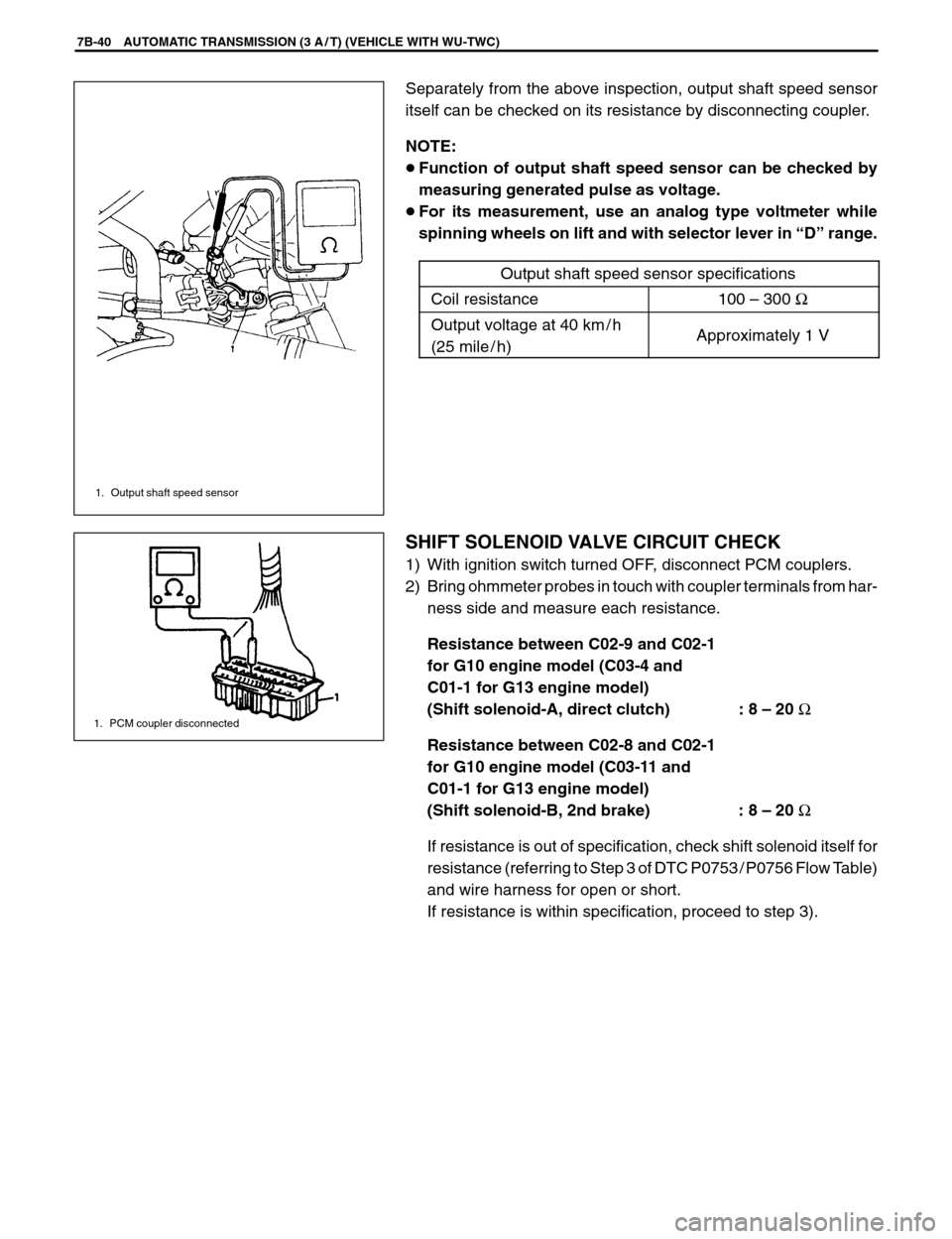Page 523 of 557

7B-32 AUTOMATIC TRANSMISSION (3 A / T) (VEHICLE WITH WU-TWC)
STALL TEST
This test is to check overall performance of automatic transmission
and engine by measuring stall speed at D and R ranges.
Be sure to perform this test only when transmission fluid is at normal
operating temperature (70–80�C / 158–176�F) and its level is be-
tween FULL HOT and LOW HOT. (Refer to “Fluid level” in this sec-
tion.)
CAUTION:
Do not run engine at stall more than 5 seconds continuous-
ly, for oil temperature may rise excessively high.
1) Install tachometer.
2) Apply parking brake and block vehicle wheels.
3) Start engine with selector lever shifted to P range.
4) Depress brake pedal.
5) Shift selector lever to D range and depress accelerator pedal ful-
ly while watching tachometer. Read engine rpm quickly when it
has become constant (stall speed).
6) Release accelerator pedal immediately after stall speed is
checked.
7) In the same way, check stall speed at R range.
8) Stall speed should be within following specification.
Stall speed: 2,500 – 2,900 r / min
(For both G10 and G13 engine models)
9) Possible causes for out-of-specification stall speed are as fol-
lows. Check each part which is suspected to be the cause.
Stall speed measured
Possible causes
Lower than specification�Engine output insufficient
�Torque converter defective
Higher than specification in
D range�Forward clutch slippage
�One-way clutch defective
Higher than specification in
R range�Direct clutch slippage
�1st-reverse brake slippage
Page 524 of 557

1. Front drive shaft (LH)
2. Oil pan
AUTOMATIC TRANSMISSION (3 A / T) (VEHICLE WITH WU-TWC) 7B-33
LINE PRESSURE TEST
This test is to check oil pressure system for operation by measuring
oil pressure in oil pressure line. Make sure to perform this test only
when transmission fluid is at normal operating temperature.
NOTE:
�Make sure that transmission fluid level is between FULL HOT
and LOW HOT marks on oil level gauge at normal operating
temperature which corresponds to 70–80�C (155–176�F) of
fluid. (Refer to “Fluid level” in this section.)
�Check that transmission is free from fluid leakage.
1) With engine at stop, remove plug and connect oil pressure
gauge to plug hole.
Special Tool
(A): 09925-37811-001
2) Install tachometer.
3) Apply parking brake and block vehicle wheels.
4) With selector lever shifted to P range, start engine.
5) Depress brake pedal fully.
6) Shift selector lever to D range and check oil pressure with engine
running at idling speed and at stall speed respectively.
7) Repeat the same check as in step 6) with selector lever shifted
to R range.
CAUTION:
Do not run engine at stall more than 5 seconds continu-
ously, for oil temperature may rise excessively high.
8) If line pressure is within respective specification in table below,
oil pressure system is in good condition.
[G10 Engine Model]
Engine speedLine pressureEngine s eedD rangeR range
Idling speed
200 – 390 kPa
2.0 – 3.9 kg / cm2
28.4 – 55.5 psi
540 – 780 kPa
5.4 – 7.8 kg / cm2
76.8 – 110.9 psi
Stall speed
390 – 590 kPa
3.9 – 5.9 kg / cm2
55.5 – 83.9 psi
880 – 1230 kPa
8.8 – 12.3 kg / cm2
125.1 – 174.9 psi
[G13 Engine Model]
Engine speedLine pressureEngine s eedD rangeR range
Idling speed
260 – 460 kPa
2.6 – 4.6 kg / cm2
37.0 – 65.4 psi
660 – 900 kPa
6.6 – 9.0 kg / cm2
93.9 – 128.0 psi
Stall speed
660 – 850 kPa
6.6 – 8.5 kg / cm2
93.9 – 120.9 psi
1330 kPa or more
13.3 kg / cm2 or more
189.0 psi or more
Page 531 of 557

1. Output shaft speed sensor
1. PCM coupler disconnected
7B-40 AUTOMATIC TRANSMISSION (3 A / T) (VEHICLE WITH WU-TWC)
Separately from the above inspection, output shaft speed sensor
itself can be checked on its resistance by disconnecting coupler.
NOTE:
�Function of output shaft speed sensor can be checked by
measuring generated pulse as voltage.
�For its measurement, use an analog type voltmeter while
spinning wheels on lift and with selector lever in “D” range.
Output shaft speed sensor specifications
Coil resistance100 – 300 Ω
Output voltage at 40 km / h
(25 mile / h)Approximately 1 V
SHIFT SOLENOID VALVE CIRCUIT CHECK
1) With ignition switch turned OFF, disconnect PCM couplers.
2) Bring ohmmeter probes in touch with coupler terminals from har-
ness side and measure each resistance.
Resistance between C02-9 and C02-1
for G10 engine model (C03-4 and
C01-1 for G13 engine model)
(Shift solenoid-A, direct clutch) : 8 – 20 Ω
Resistance between C02-8 and C02-1
for G10 engine model (C03-11 and
C01-1 for G13 engine model)
(Shift solenoid-B, 2nd brake) : 8 – 20 Ω
If resistance is out of specification, check shift solenoid itself for
resistance (referring to Step 3 of DTC P0753 / P0756 Flow Table)
and wire harness for open or short.
If resistance is within specification, proceed to step 3).